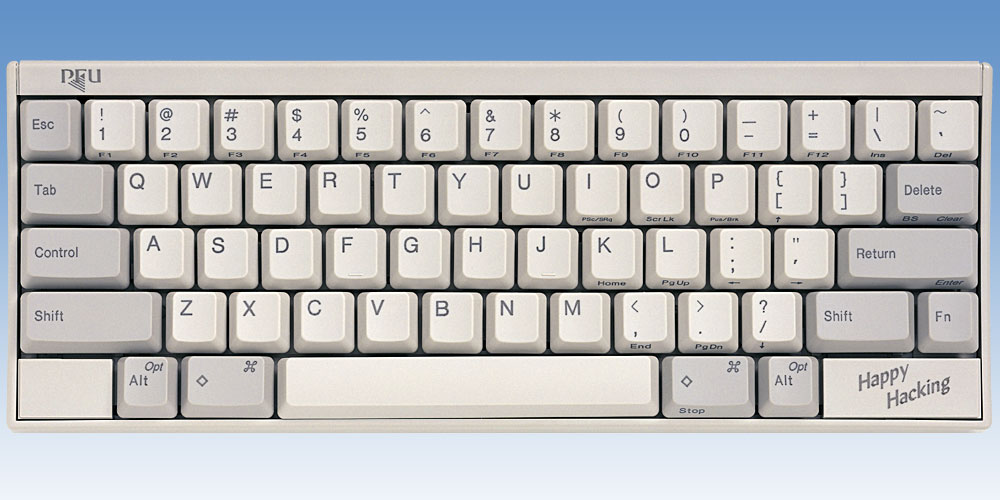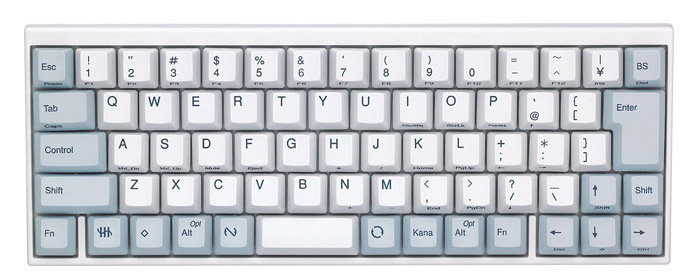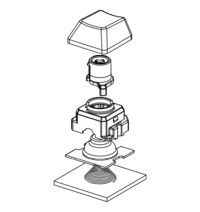History
The Happy Hacking Keyboard layout was designed by Eiiti Wada, a Japanese computer scientist.
From Wikipedia:
Frustrated that each new computer system came with a new keyboard layout that became increasingly complex, Wada sought to create his own keyboard that he could continue to use with various different computer systems. Inspired by the original Macintosh keyboard, Professor Wada and PFU collaborated to design the Happy Hacking Keyboard. During the design process, Wada had mock-ups of the keyboard both with printed and blank keycaps; he found that his students quite liked blank keycaps and the tradition of HHKB's with blank keycaps continues to this day.
The Happy Hacking Keyboard (1996–2003)

The original Happy Hacking Keyboard (PD-KB01 and PD-KB02) used standard rubber domes over membrane switches, producing a similar experience to a typical OEM keyboard (though arguably higher-quality than most keyboards sold with PCs). The keyboard came with removable cables to support PS/2, Sun and ADB connectivity (for PC, Sun and Macintosh computers, respectively). It was also the first keyboard sold with a blank keycap option.
Happy Hacking Keyboard Professional (2003–2006)

The Happy Hacking Professional (PD-KB300) series introduced the Topre electrostatic capacitive keyswitch technology, now used in all Happy Hacking keyboards produced by PFU.
This model introduced the new HHKB logo and saw the removal of the PFU branding above the Esc and 1 keys.
This was also the first line to use USB.
Happy Hacking Professional 2 (2006–2019)

The Happy Hacking Professional 2 (PD-KB400) launched in 2006 as the first successor to the Professional. The PD-KB400 line introduced a built-in 2-port USB-A hub for use with low-power peripherals (eg mice and flash drives).

Happy Hacking Professional JP (2008-2019)

The Happy Hacking Professional JP (PD-KB420) was released in 2008 and featured a modified JIS layout. This model did not include a built-in USB hub.
Noteably, the JP line (and the JIS variants of the Professional Hybrid series) are the only Topre Happy Hacking Keyboards with dedicated arrow keys.
Type-S (2011)
In 2011, PFU released new Type-S variants of the Professional 2 and JP, which were modeled after the Realforce Silent series. These models featured a 'Type-S' imprint on the top-right corner of the case and included modifed sliders with silencing rings that dampened the sound produced on the upstroke of each keypress.

Happy Hacking Professional BT

The HHKB Professional BT was released in 2016. It was the first model with built-in Bluetooth capabilities, but unfortunately, the USB port only worked to supply power to the keyboard. Because of this, the Professional BT could only be used with devices that support Bluetooth.
The Professional BT did not include a USB hub.
Happy Hacking Professional Classic and Hybrid (2019–present)

The Professional Classic and Hybrid models are the only models currently manufactured by PFU. The Classic line is a direct successor to the Professional 2 series (although without a USB hub. It also uses a USB-C connector instead of the mini-USB connector found on previous Professional models.
The Hybrid series is the first in the product line to support both Bluetooth and USB-C connections. This series also includes Type-S and JIS variants.
Happy Hacking Keyboard Lite
Between the release of the PD-KB01 and the Professional line, PFU launched the Happy Hacking Keyboard Lite series. More information to come, once I exhaust the Professional series 😎
